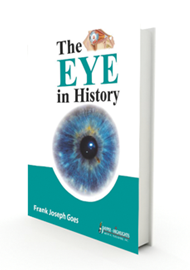Amongst the numerous texts that are available, one occasionally encounters a history of ophthalmology. There is such rapid development of technology in recent years and one can get drawn into the minutiae of a particular subject, losing track of the overall breadth of our visual experiences that extend well beyond the clinical environment.
It is worth drawing our attention to the foundations upon which the profession is based and recognising the contributions our predecessors have made, bearing in mind that ophthalmology has both science and art components and a past, a present and a future.
How can one define ‘history’, and does the term ‘eye’ refer merely to an anatomical structure? In this book, ‘history’ extends from the earliest recorded studies of human vision, key practitioners associated with ophthalmology or personally affected by deficits in their own visual system through our recent past to the present day diagnostic instrumentation and treatments. The ‘eye’ includes the anatomy, diseases and treatments of the eyeball, but also explores the nature of light, visual perception, visual aids, cataract and refractive surgery.
This is a densely packed book with ten colour-coded sections, fifty chapters and accompanying bibliographies, the latter particularly numerous for the corneal and refractive sections. Its contents are a ‘potpourri’ to tempt the visual interest, with numerous illustrations, ranging from old woodcut drawings, paintings, philatelic artwork, technical diagrams of surgical procedures, and computer generated diagnostic images. This book has been written for the benefit of the lay person, general practitioner and ophthalmic specialist, which inevitably leads to a compromise in the depth of detail and unfortunately the figure numbers and captions do not always correspond with the body of the text. There are also some difficulties in logically organising the extremely diverse material.
The main author’s background as an internationally recognised specialist in refractive surgery leads to a bias in the eye surgery section towards anterior segment procedures including cataract and refractive procedures, briefly referring to posterior and vitreoretinal surgery. Visual aids including spectacles, contact lenses and intraocular lenses are generously presented. There is an excellent table in the chapter entitled ‘The Collyria Eye Drops’ which summarises recently developed pharmaceutical preparations and their packaging.
Little attention is given to the anomalies of extraocular musculature, correction of binocular vision anomalies, the use of Botulinum toxin, eyelid, lacrimal or neuro-surgery.
An excellent book for the staff / common room to read during rest and meal breaks for light-relief as the chapters are short and self-contained. Not an easy book to read from ‘front-to-back’ as some repetition of topics and the writing style varies between the contributors. Personal impressions and anecdotes are ‘sprinkled’ throughout the chapters that might frustrate or irritate the serious reader.
It is very difficult to choose which material should be included in such an eclectic mix, and the book could easily be expanded to further volumes, but the cost would become restrictive and the novelty element might become ‘tired’. Based on the overall enjoyment felt browsing through this book it deserved a value rating of 3/5.




